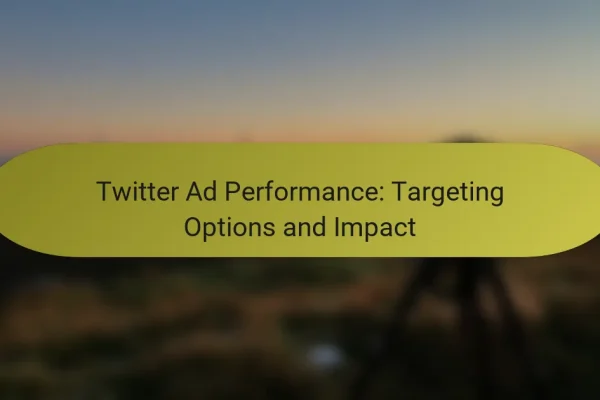How can Twitter Ads generate leads in Australia?
Twitter Ads can effectively generate leads in Australia by targeting specific audiences and utilizing engaging ad formats. By leveraging real-time analytics, businesses can optimize their campaigns to attract potential customers and convert them into leads.
Targeted audience segmentation
Targeted audience segmentation allows advertisers to reach specific demographics, interests, and behaviors on Twitter. In Australia, businesses can create tailored campaigns that resonate with local audiences by using criteria such as location, age, and interests.
Utilizing Twitter’s audience insights, companies can refine their targeting to focus on users who are more likely to engage with their ads. This increases the chances of lead generation by ensuring that the right message reaches the right people.
Engaging ad formats
Twitter offers various engaging ad formats that can capture attention and drive user interaction. Options like Promoted Tweets, Promoted Accounts, and Twitter Cards can be utilized to showcase products or services effectively.
For instance, using video ads or carousel ads can enhance user engagement, making it easier for potential leads to learn about offerings. Experimenting with different formats can help identify which resonates best with the target audience in Australia.
Real-time analytics
Real-time analytics provide valuable insights into campaign performance, allowing advertisers to make data-driven decisions. By monitoring metrics such as engagement rates, click-through rates, and conversions, businesses can adjust their strategies promptly.
In Australia, leveraging these analytics can help identify trends and optimize ad spend, ensuring that resources are allocated efficiently to maximize lead generation. Regularly reviewing performance can lead to continuous improvement in ad effectiveness.
What are the best practices for Twitter Ads?
The best practices for Twitter Ads focus on creating engaging content that resonates with your target audience. By following effective strategies in ad copy, visuals, and calls-to-action, you can enhance your lead generation efforts on this platform.
Crafting compelling ad copy
Compelling ad copy is crucial for capturing attention and driving engagement. Start with a strong headline that clearly communicates your value proposition. Use concise language and focus on the benefits your product or service offers.
Incorporate relevant keywords to improve visibility and appeal to your target audience. Avoid jargon and keep the tone conversational to make your message relatable. Testing different variations can help identify what resonates best with your audience.
Utilizing visuals effectively
Effective visuals can significantly enhance the impact of your Twitter Ads. Use high-quality images or videos that align with your brand and message. Visuals should be eye-catching and relevant, as they can increase engagement rates by drawing users’ attention.
Consider using infographics or short clips to convey complex information quickly. Ensure that your visuals are optimized for mobile devices, as a significant portion of Twitter users access the platform via smartphones.
Incorporating strong calls-to-action
Strong calls-to-action (CTAs) guide users on what to do next after viewing your ad. Use clear and direct language, such as “Sign Up Now” or “Learn More,” to prompt immediate action. Position your CTA prominently within the ad to ensure it stands out.
Experiment with different CTAs to see which ones drive the most conversions. Keep in mind that urgency can be effective; phrases like “Limited Time Offer” can encourage quicker responses from potential leads.
How to set up a Twitter Ads campaign?
Setting up a Twitter Ads campaign involves creating an account, defining your objectives, and establishing your budget. This process allows you to effectively target potential leads through tailored advertising strategies on the platform.
Creating a Twitter Ads account
To create a Twitter Ads account, you need an existing Twitter profile. Navigate to the Twitter Ads homepage and click on “Start Advertising.” Follow the prompts to set up your account, including selecting your country and time zone, which will help tailor your ad experience.
Ensure that your Twitter profile is complete and professional, as this will reflect on your ads. A well-optimized profile can enhance credibility and attract more leads.
Defining campaign objectives
Clearly defining your campaign objectives is crucial for success. Twitter allows you to choose from various objectives, such as increasing website traffic, generating leads, or boosting engagement. Select an objective that aligns with your overall marketing goals.
Consider the specific actions you want users to take. For instance, if your goal is lead generation, focus on objectives that encourage sign-ups or downloads. This clarity will guide your ad creation and targeting strategies.
Budgeting and bidding strategies
Establishing a budget and selecting a bidding strategy are essential steps in your Twitter Ads campaign. You can set a daily or total budget, allowing you to control your spending effectively. Twitter offers various bidding options, including automatic and manual bidding.
For lead generation, consider starting with a modest budget to test different ads and audiences. Monitor performance and adjust your budget based on what works best. Avoid overspending by regularly reviewing your campaign metrics and making data-driven decisions.
What metrics should be tracked for lead generation?
To effectively measure lead generation through Twitter Ads, focus on key metrics such as click-through rates, conversion rates, and cost per lead. These metrics provide insight into the performance of your campaigns and help optimize your advertising strategy.
Click-through rates
Click-through rates (CTR) indicate the percentage of users who click on your ad after seeing it. A higher CTR suggests that your ad is engaging and relevant to your target audience. Aim for a CTR of around 1-3% as a benchmark, but this can vary by industry.
To improve CTR, consider using compelling visuals and clear calls to action. Regularly testing different ad formats and messaging can help identify what resonates best with your audience.
Conversion rates
Conversion rates measure the percentage of users who take a desired action after clicking on your ad, such as signing up for a newsletter or making a purchase. A strong conversion rate indicates that your landing page and offer are effectively aligned with user expectations. Typical conversion rates can range from 2-10%, depending on the industry and offer.
To enhance conversion rates, ensure that your landing page is optimized for user experience, loads quickly, and clearly communicates the value of your offer. A/B testing different landing page designs can help pinpoint the most effective elements.
Cost per lead
Cost per lead (CPL) is the amount spent on advertising to acquire a single lead. Understanding your CPL helps assess the efficiency of your ad spend. A reasonable CPL varies widely but generally falls between $20 and $100, depending on the market and competition.
To lower your CPL, focus on targeting the right audience and refining your ad copy. Regularly analyze your campaigns to identify underperforming ads and reallocating budget towards those that yield better results can also be beneficial.
What are the common challenges with Twitter Ads?
Twitter Ads can present several challenges that marketers must navigate for effective lead generation. Common issues include ad fatigue, budget constraints, and intense competition for audience attention.
Ad fatigue
Ad fatigue occurs when users see the same ad repeatedly, leading to decreased engagement and effectiveness. To combat this, regularly refresh your ad creatives and messaging to maintain audience interest. Consider A/B testing different formats and visuals to determine what resonates best with your target demographic.
Monitoring engagement metrics can help identify when ad fatigue sets in. If click-through rates drop significantly, it may be time to rotate your ads or introduce new content.
Budget constraints
Budget constraints can limit the reach and frequency of your Twitter Ads. It’s essential to establish a clear budget that aligns with your lead generation goals while allowing for flexibility in ad spend. Start with a modest budget and scale up based on performance metrics.
Utilize Twitter’s targeting options to maximize your budget efficiency. Focus on specific demographics or interests that align with your ideal customer profile to ensure your ads reach the most relevant audience.
Competition for audience attention
With numerous brands vying for attention on Twitter, standing out is crucial. Craft compelling ad copy and visuals that capture interest quickly, as users often scroll through their feeds rapidly. Highlight unique selling points or offers that differentiate your brand from competitors.
Engagement strategies, such as using polls or interactive content, can also enhance user interaction. Consider timing your ads to coincide with peak user activity periods to increase visibility and engagement rates.
How to optimize Twitter Ads for better performance?
To optimize Twitter Ads for better performance, focus on A/B testing different ad variations and adjusting targeting parameters. These strategies can significantly enhance engagement and conversion rates, leading to more effective lead generation.
A/B testing ad variations
A/B testing involves creating two or more versions of an ad to determine which performs better. By changing elements such as headlines, images, or calls to action, you can identify what resonates most with your audience.
Start with small changes to minimize risk. For instance, if you have a campaign with a budget of $100, allocate $50 to each ad variation. Monitor performance over a week to gather sufficient data before making decisions.
Adjusting targeting parameters
Adjusting targeting parameters allows you to reach the most relevant audience for your ads. Consider factors like demographics, interests, and behaviors to refine your audience and increase the likelihood of engagement.
Utilize Twitter’s audience insights to understand your current followers and tailor your targeting accordingly. For example, if your product appeals to young professionals, focus on age groups between 25-35 in urban areas. Regularly review and adjust these parameters based on campaign performance to ensure optimal reach.










